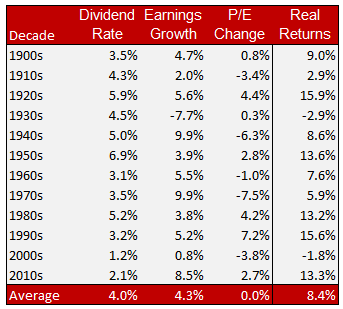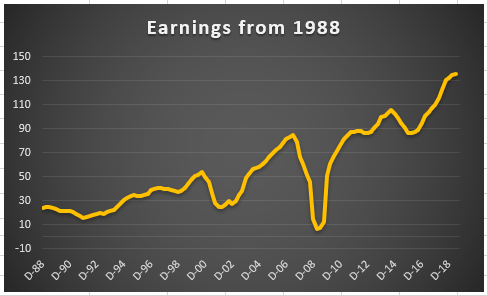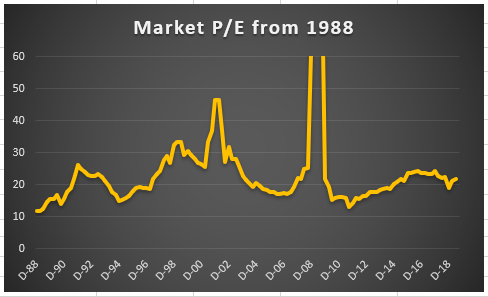Situational Awareness
Lesson 2 Module 1
Situational awareness differs from self awareness in one important way. While self awareness is all about looking inward with honesty and courage, situational awareness is about looking outward and reading the signals that are buried deep within in the noise of the financial media.
How good is your sense of situational awareness?
The financial media generates a wall of white noise that one goal - to attract your attention so advertisers will pay them for access to your eyeballs. These advertisers want to entice you to buy their expert advice, investment products, trading systems, paid subscriptions, and solutions to all your financial problems. This white noise is needlessly complex and overwhelming.
The thing that's so maddening is that buried within the wall of noise is a signal. Most investors are helpless when it comes to finding the signal. But this is a skill that can be learned, and this course will teach you how to get it.
...
What drives market prices?
- 1Dividends
- 2Company Earnings
- 3Investor Sentiment
This idea originated from the work of the late, great Jack Bogle - inventor of index investing and founder of the Vanguard Funds.
According to Bogle, these three factors account for more than 90% of market value. He also allowed for a so-called X-Factor which can't be observed directly but can nudge the market price away from its fair value for brief periods.
Let's unpack these three factors one at a time. As we go through each factor, see the chart below for a decade-by-decade breakdown of the historical record.
1. Dividends
Of the three factors that influence the stock market, dividends are the most stable. But you can see that dividends vary widely from decade to decade. In today's corporate environment, dividends have been given a back seat to share buybacks and executive bonuses.
But for much of market history, dividends were a dominant contributor to market returns.
2. Company Earnings
Over the decades, company earnings have been volatile, with a long term average of 4.3% growth. The worst decade for earnings was the 1930's during the Great Depression. Companies were bleeding money and going out of business in droves.
But in our current decade earnings have been growing nicely, due in part to easy comparisons to the previous decade.
Look at the chart below. It shows the track of annual earnings for the market since 1988. Although there are some bumps in the road, like 2008-2009, the trend has been steadily upward.
3. P/E Change
This is where things start to get interesting. P/E change is just a measure of investor sentiment. The big question is how much are investors willing to pay for $1 of earnings? In other words, how optimistic or pessimistic are investors about the market?
The table above shows that the long-term change in P/E is zero. This is as it should be. It doesn't mean that the P/E itself is zero, it means that over time, the change in P/E is zero.
The long-term P/E for the market is roughly 15, which means that in a normal market environment investors will pay $15 for every $1 of earnings. But when investors are fearful about the future, they have paid as little as $10 for $1 of earnings. When they are optimistic they have paid as much as $120 for that same $1 dollar of earnings.
Look at the chart below. I clipped the vertical scale at 60 so the rest of the numbers are easier to read. The spike in 2008-2009 took the P/E to 120. That was an aberration.
However, you can plainly see how volatile the market P/E is over time. This fact drives market pundits crazy because it makes their job nearly impossible. They have a good idea about where dividends and earnings might be headed next, but they don't have a clue about investor sentiment, as reflected in the P/E numbers.
What drives stock prices?
- 1Earnings surprises
- 2Estimate revisions
- 3Rating changes
When it comes to the price behavior of individual stocks, it's all about earnings and analyst ratings. Most publicly traded companies are scrutinized by highly skilled, highly paid analysts working for major Wall Street firms.
Some companies, especially small ones, aren't followed by any analysts. Others have 1 or 2 followers. And as they grow in size and market share they can attract the attention of 10 or more analysts who follow their every move.
Most companies offer "guidance" to analysts and investors to inform them about how well their business is doing. This guidance includes estimates for revenue and earnings for the upcoming quarter and year. These company-provided numbers represent the baseline that analysts use to make forecasts about where the stock price might be headed next.
The analysts don't necessarily take the company guidance at face value. More often they adjust their estimates higher or lower, based on their familiarity with trends in the industry the company is in. Sometimes these analyst numbers are very different from company numbers.
Finally, there are the actual numbers reported by the company at the end of the quarter. This is where things get interesting. When the actual numbers are announced, they very often differ significantly from company guidance and/or analyst expectations. These are earnings surprises, and they usually send the stock price sharply higher or lower after the announcement.
An investor who has good situational awareness, and invests in individual stocks, will know what the guidance is, what analyst expectations are, and when the company will report the actual numbers. If you don't have the time or patience to keep track of these numbers, then you probably should not invest in individual stocks. Stick with mutual funds or ETFs, where it doesn't matter nearly as much.
What causes recessions and bear markets?
- 1Rising unemployment
- 2Rising inflation expectations
- 3A tightening of Federal Reserve policy
- 4Mean reversion
Situational awareness requires an investor to pay attention to all four of the above. The elephant in the room is the onset of an economic recession, because it takes nearly every capital asset down with it. Bonds can be a safe haven, but you have to be in the right part of the bond market to avoid getting hurt.
You may be thinking "recessions only happen about every 10 years, so why even bother to monitor them?" Let me remind you that we had back-to-back recessions in 1980 and 1981. Economists euphemistically refer to this as the "double-dip" recession. Don't think it could happen again? Then you need to work on your situational awareness skills.
Warning Signs
1. When the year-over-year change in the unemployment rate crosses below 1%, that's a recession warning. It means that the labor market is getting tight, and there's little room for improvement.
2. The baseline rate of inflation is roughly 3%. The economy tends to thrive when inflation is around this level. But when it drops below 2%, consumers start to worry about deflation like we saw during the Great Depression of the 1930's. They stop spending, and the economy sinks farther into a funk. That's what inflation expectations do.
If inflation begins to rise sharply, as it did in the 1970's, consumers tend to spend today rather than waiting until tomorrow when prices will be even higher. What's wrong with that, you might ask.
What's wrong is that an inflation spiral begins to feed on itself, driving prices higher and higher, until you can no longer afford the price of necessities like food and gas for your car. In the U.S. inflation has been as high as 19.7% (1917). In a hyperinflation, the rate can, and has, reached 400% (Taiwan, 1945), 438% (Armenia, 1993), and the world record, 8,000% (Zimbabwe, 2008).
I'm not telling this to scare you. I'm telling you this because sharp changes in inflation can spell serious trouble. An investor with good situational awareness will keep an eye on inflation.
The danger of clinging to old ideas
I had a client who told me she learned everything she would ever need to know about investing from her grandfather. That's very sweet, but unless grandpa was a master investor, he just passed his own biased beliefs to his granddaughter. She loved him so much that she refused to consider the possibility that some of his sage advice might have been wrong.
Try as I might to disabuse her of the wrong-headed notions her grandpa gave her, she steadfastly clung to his views. I was forced to construct a portfolio that looked like something her grandpa would have liked, but was actually designed to take full advantage of the current situation in the market. It was a win for us both. Here are a few of her grandpa's ideas that were just wrong.
- Don't buy any stock that costs more than $20 per share. They are too expensive.
- Only buy stocks of companies that are familiar to you, like Polaroid, Blockbuster, and Sears.
- Once you buy a stock, never sell it. Don't worry if it goes down. It will always come back up.
- Never buy a stock that doesn't pay dividends. Those stocks are always losers.
- Only buy good stocks that go up. If they don't go up, then don't buy them.
Grandpa may have been a wise man in the ways of the world, but his investment advice was terrible. It cost his granddaughter a small fortune over the years. She clung to his advice and refused to go against any of the principles grandpa laid out for her.




Leave a comment
Comment as a guest: